inflation pressure Lancia Delta 2010 Owner handbook (in English)
[x] Cancel search | Manufacturer: LANCIA, Model Year: 2010, Model line: Delta, Model: Lancia Delta 2010Pages: 276, PDF Size: 5.31 MB
Page 19 of 276
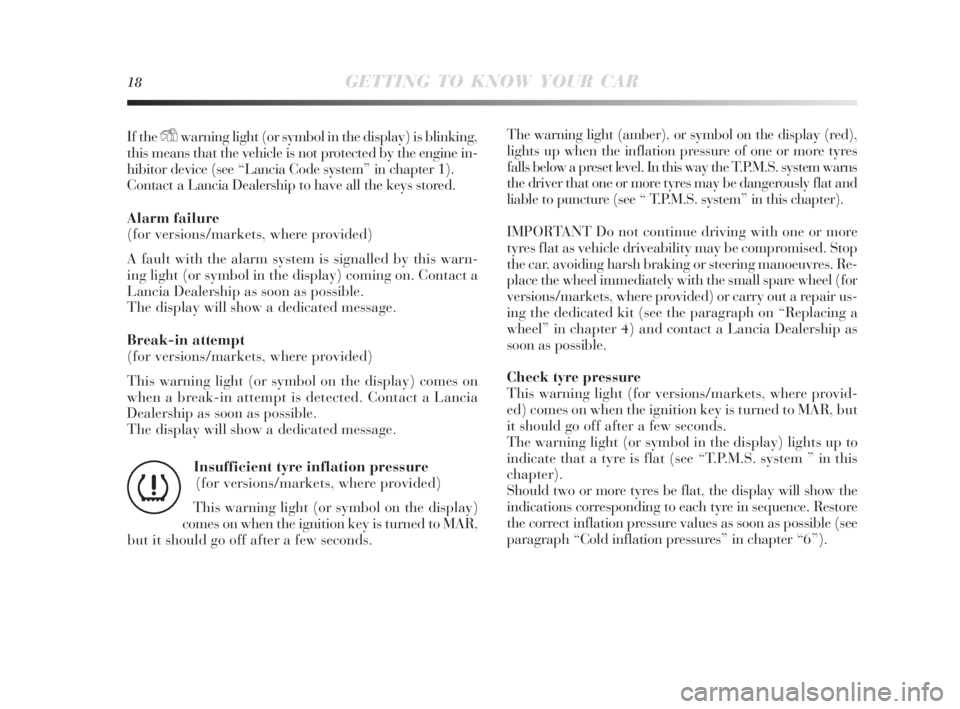
18GETTING TO KNOW YOUR CAR
If the Ywarning light (or symbol in the display) is blinking,
this means that the vehicle is not protected by the engine in-
hibitor device (see “Lancia Code system” in chapter 1).
Contact a Lancia Dealership to have all the keys stored.
Alarm failure
(for versions/markets, where provided)
A fault with the alarm system is signalled by this warn-
ing light (or symbol in the display) coming on. Contact a
Lancia Dealership as soon as possible.
The display will show a dedicated message.
Break-in attempt
(for versions/markets, where provided)
This warning light (or symbol on the display) comes on
when a break-in attempt is detected. Contact a Lancia
Dealership as soon as possible.
The display will show a dedicated message.The warning light (amber), or symbol on the display (red),
lights up when the inflation pressure of one or more tyres
falls below a preset level. In this way the T.P.M.S. system warns
the driver that one or more tyres may be dangerously flat and
liable to puncture (see “ T.P.M.S. system” in this chapter).
IMPORTANT Do not continue driving with one or more
tyres flat as vehicle driveability may be compromised. Stop
the car, avoiding harsh braking or steering manoeuvres. Re-
place the wheel immediately with the small spare wheel (for
versions/markets, where provided) or carry out a repair us-
ing the dedicated kit (see the paragraph on “Replacing a
wheel” in chapter 4) and contact a Lancia Dealership as
soon as possible.
Check tyre pressure
This warning light (for versions/markets, where provid-
ed) comes on when the ignition key is turned to MAR, but
it should go off after a few seconds.
The warning light (or symbol in the display) lights up to
indicate that a tyre is flat (see “T.P.M.S. system ” in this
chapter).
Should two or more tyres be flat, the display will show the
indications corresponding to each tyre in sequence. Restore
the correct inflation pressure values as soon as possible (see
paragraph “Cold inflation pressures” in chapter “6”). Insufficient tyre inflation pressure
(for versions/markets, where provided)
This warning light (or symbol on the display)
comes on when the ignition key is turned to MAR,
but it should go off after a few seconds.
n
001-142 Delta 3ed gb 30-11-2009 11:21 Pagina 18
Page 20 of 276
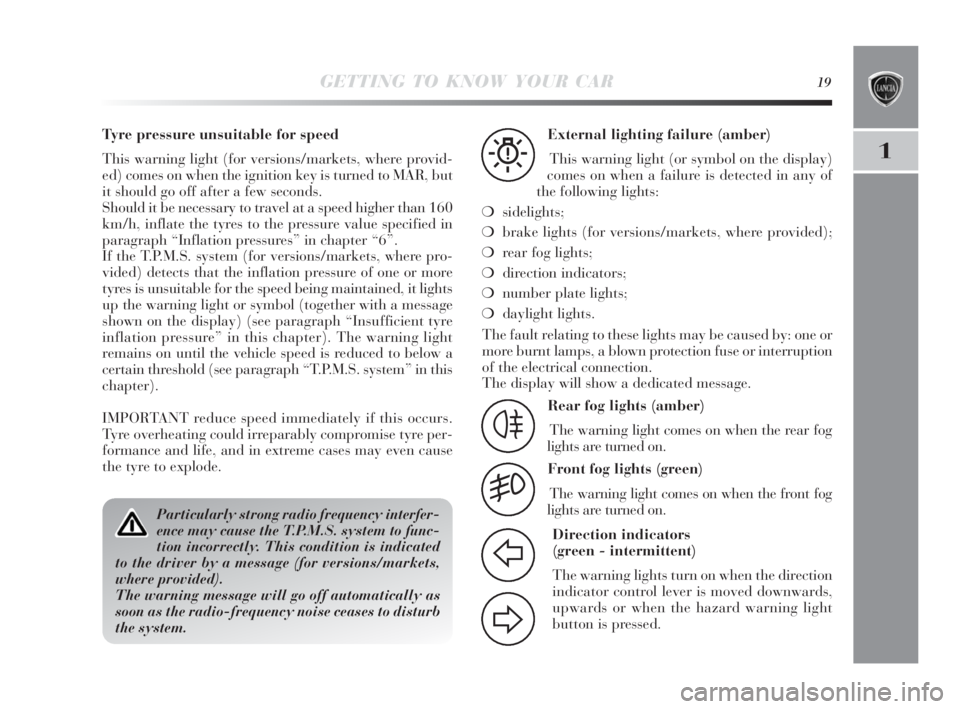
GETTING TO KNOW YOUR CAR19
1
Particularly strong radio frequency interfer-
ence may cause the T.P.M.S. system to func-
tion incorrectly. This condition is indicated
to the driver by a message (for versions/markets,
where provided).
The warning message will go off automatically as
soon as the radio-frequency noise ceases to disturb
the system.
External lighting failure (amber)
This warning light (or symbol on the display)
comes on when a failure is detected in any of
the following lights:
❍sidelights;
❍brake lights (for versions/markets, where provided);
❍rear fog lights;
❍direction indicators;
❍number plate lights;
❍daylight lights.
W
Rear fog lights (amber)
The warning light comes on when the rear fog
lights are turned on.
4
Front fog lights (green)
The warning light comes on when the front fog
lights are turned on.
5
Direction indicators
(green - intermittent)
The warning lights turn on when the direction
indicator control lever is moved downwards,
upwards or when the hazard warning light
button is pressed.
F
D
Tyre pressure unsuitable for speed
This warning light (for versions/markets, where provid-
ed) comes on when the ignition key is turned to MAR, but
it should go off after a few seconds.
Should it be necessary to travel at a speed higher than 160
km/h, inflate the tyres to the pressure value specified in
paragraph “Inflation pressures” in chapter “6”.
If the T.P.M.S. system (for versions/markets, where pro-
vided) detects that the inflation pressure of one or more
tyres is unsuitable for the speed being maintained, it lights
up the warning light or symbol (together with a message
shown on the display) (see paragraph “Insufficient tyre
inflation pressure” in this chapter). The warning light
remains on until the vehicle speed is reduced to below a
certain threshold (see paragraph “T.P.M.S. system” in this
chapter).
IMPORTANT reduce speed immediately if this occurs.
Tyre overheating could irreparably compromise tyre per-
formance and life, and in extreme cases may even cause
the tyre to explode.The fault relating to these lights may be caused by: one or
more burnt lamps, a blown protection fuse or interruption
of the electrical connection.
The display will show a dedicated message.
001-142 Delta 3ed gb 30-11-2009 11:21 Pagina 19
Page 118 of 276
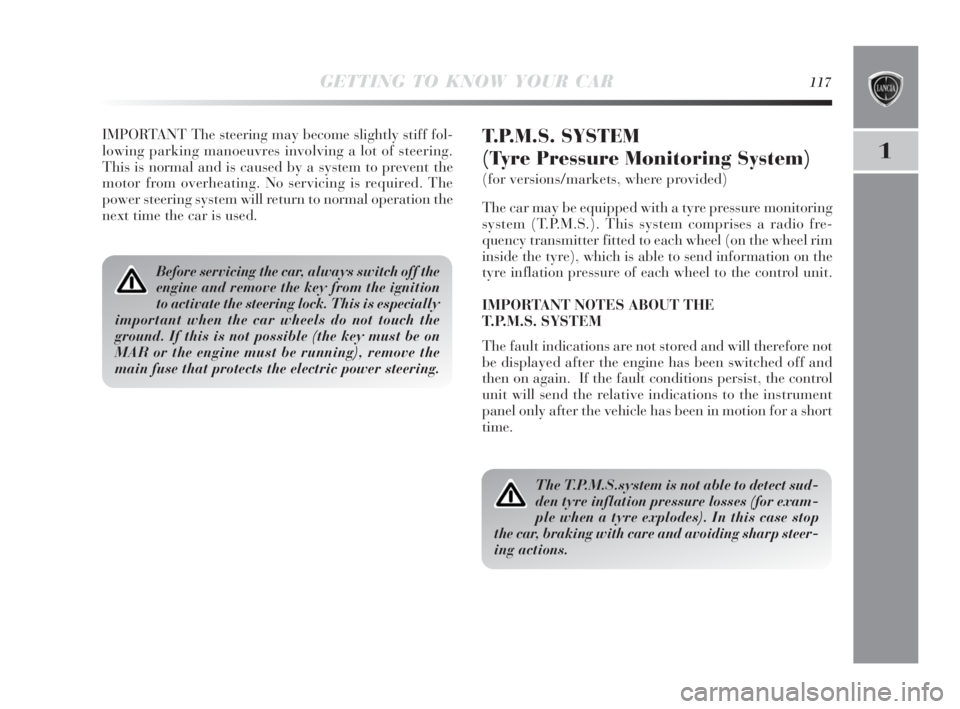
GETTING TO KNOW YOUR CAR117
1
IMPORTANT The steering may become slightly stiff fol-
lowing parking manoeuvres involving a lot of steering.
This is normal and is caused by a system to prevent the
motor from overheating. No servicing is required. The
power steering system will return to normal operation the
next time the car is used.T.P.M.S. SYSTEM
(Tyre Pressure Monitoring System)
(for versions/markets, where provided)
The car may be equipped with a tyre pressure monitoring
system (T.P.M.S.). This system comprises a radio fre-
quency transmitter fitted to each wheel (on the wheel rim
inside the tyre), which is able to send information on the
tyre inflation pressure of each wheel to the control unit.
IMPORTANT NOTES ABOUT THE
T.P.M.S. SYSTEM
The fault indications are not stored and will therefore not
be displayed after the engine has been switched off and
then on again. If the fault conditions persist, the control
unit will send the relative indications to the instrument
panel only after the vehicle has been in motion for a short
time.
Before servicing the car, always switch off the
engine and remove the key from the ignition
to activate the steering lock. This is especially
important when the car wheels do not touch the
ground. If this is not possible (the key must be on
MAR or the engine must be running), remove the
main fuse that protects the electric power steering.
The T.P.M.S.system is not able to detect sud-
den tyre inflation pressure losses (for exam-
ple when a tyre explodes). In this case stop
the car, braking with care and avoiding sharp steer-
ing actions.
001-142 Delta 3ed gb 30-11-2009 11:22 Pagina 117
Page 119 of 276
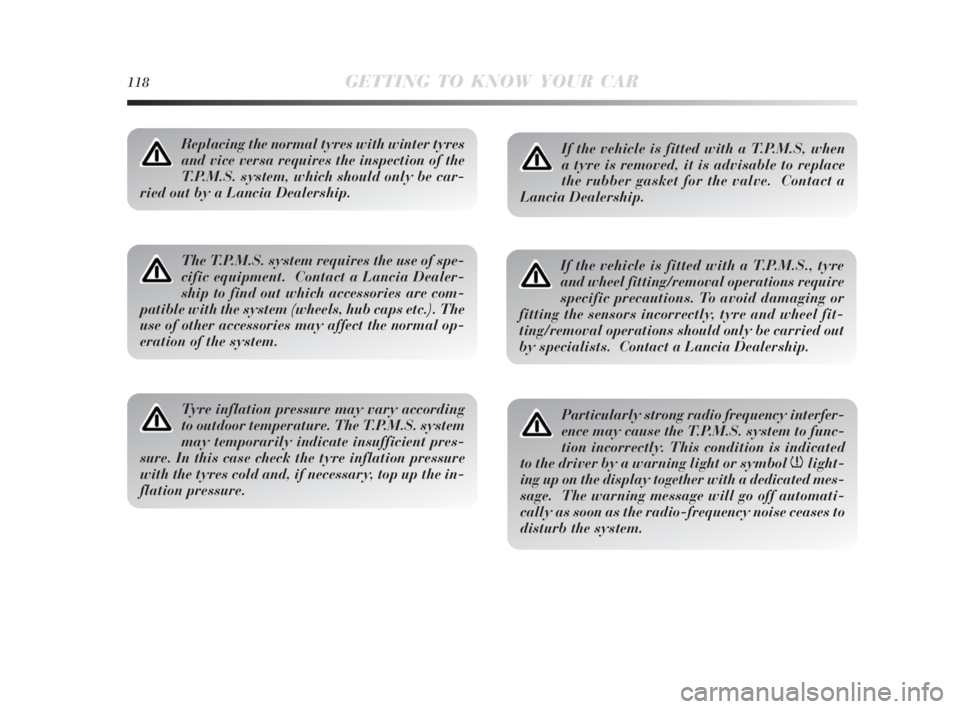
118GETTING TO KNOW YOUR CAR
Replacing the normal tyres with winter tyres
and vice versa requires the inspection of the
T.P.M.S. system, which should only be car-
ried out by a Lancia Dealership.
The T.P.M.S. system requires the use of spe-
cific equipment. Contact a Lancia Dealer-
ship to find out which accessories are com-
patible with the system (wheels, hub caps etc.). The
use of other accessories may affect the normal op-
eration of the system.
Tyre inflation pressure may vary according
to outdoor temperature. The T.P.M.S. system
may temporarily indicate insufficient pres-
sure. In this case check the tyre inflation pressure
with the tyres cold and, if necessary, top up the in-
flation pressure.
If the vehicle is fitted with a T.P.M.S, when
a tyre is removed, it is advisable to replace
the rubber gasket for the valve. Contact a
Lancia Dealership.
If the vehicle is fitted with a T.P.M.S., tyre
and wheel fitting/removal operations require
specific precautions. To avoid damaging or
fitting the sensors incorrectly, tyre and wheel fit-
ting/removal operations should only be carried out
by specialists. Contact a Lancia Dealership.
Particularly strong radio frequency interfer-
ence may cause the T.P.M.S. system to func-
tion incorrectly. This condition is indicated
to the driver by a warning light or symbol
nlight-
ing up on the display together with a dedicated mes-
sage. The warning message will go off automati-
cally as soon as the radio-frequency noise ceases to
disturb the system.
001-142 Delta 3ed gb 30-11-2009 11:22 Pagina 118
Page 174 of 276
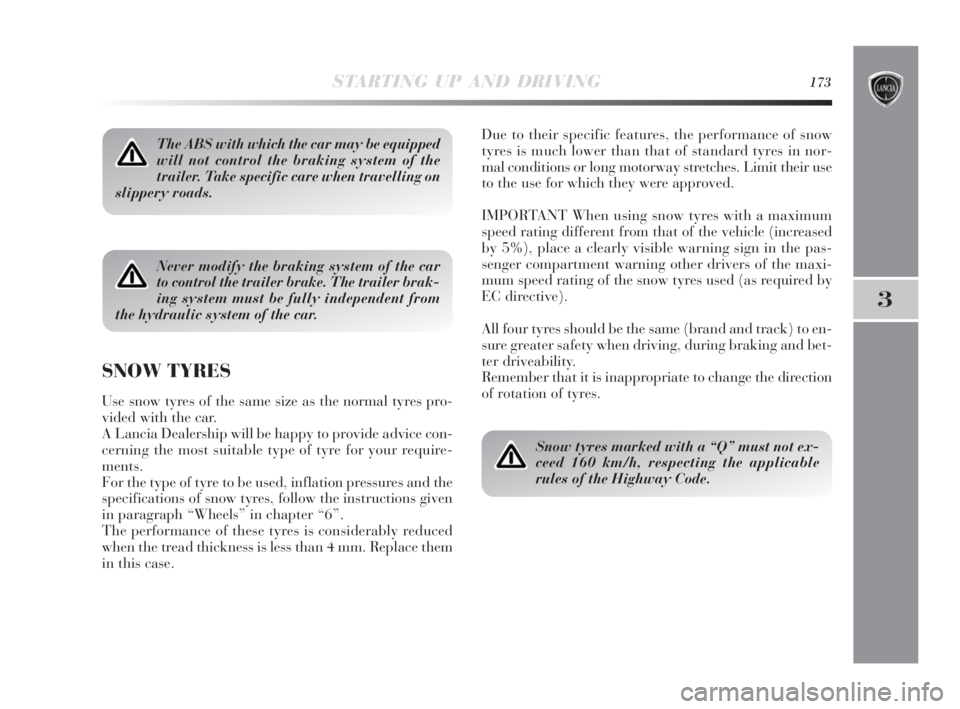
STARTING UP AND DRIVING173
3
The ABS with which the car may be equipped
will not control the braking system of the
trailer. Take specific care when travelling on
slippery roads.
Never modify the braking system of the car
to control the trailer brake. The trailer brak-
ing system must be fully independent from
the hydraulic system of the car.
SNOW TYRES
Use snow tyres of the same size as the normal tyres pro-
vided with the car.
A Lancia Dealership will be happy to provide advice con-
cerning the most suitable type of tyre for your require-
ments.
For the type of tyre to be used, inflation pressures and the
specifications of snow tyres, follow the instructions given
in paragraph “Wheels” in chapter “6”.
The performance of these tyres is considerably reduced
when the tread thickness is less than 4 mm. Replace them
in this case.Due to their specific features, the performance of snow
tyres is much lower than that of standard tyres in nor-
mal conditions or long motorway stretches. Limit their use
to the use for which they were approved.
IMPORTANT When using snow tyres with a maximum
speed rating different from that of the vehicle (increased
by 5%), place a clearly visible warning sign in the pas-
senger compartment warning other drivers of the maxi-
mum speed rating of the snow tyres used (as required by
EC directive).
All four tyres should be the same (brand and track) to en-
sure greater safety when driving, during braking and bet-
ter driveability.
Remember that it is inappropriate to change the direction
of rotation of tyres.
Snow tyres marked with a “Q” must not ex-
ceed 160 km/h, respecting the applicable
rules of the Highway Code.
165-174 Delta 3ed gb 11-11-2009 12:10 Pagina 173
Page 182 of 276
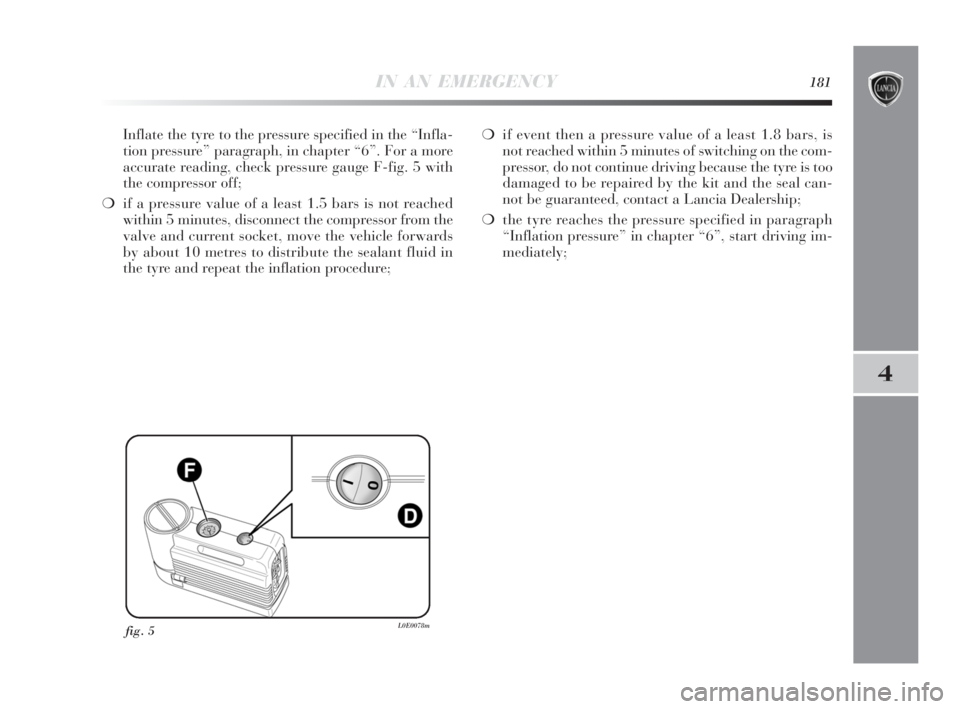
IN AN EMERGENCY181
4
Inflate the tyre to the pressure specified in the “Infla-
tion pressure” paragraph, in chapter “6”. For a more
accurate reading, check pressure gauge F-fig. 5 with
the compressor off;
❍if a pressure value of a least 1.5 bars is not reached
within 5 minutes, disconnect the compressor from the
valve and current socket, move the vehicle forwards
by about 10 metres to distribute the sealant fluid in
the tyre and repeat the inflation procedure;❍if event then a pressure value of a least 1.8 bars, is
not reached within 5 minutes of switching on the com-
pressor, do not continue driving because the tyre is too
damaged to be repaired by the kit and the seal can-
not be guaranteed, contact a Lancia Dealership;
❍the tyre reaches the pressure specified in paragraph
“Inflation pressure” in chapter “6”, start driving im-
mediately;
fig. 5L0E0078m
175-214 Delta 4ed gb 24-02-2010 14:36 Pagina 181
Page 187 of 276
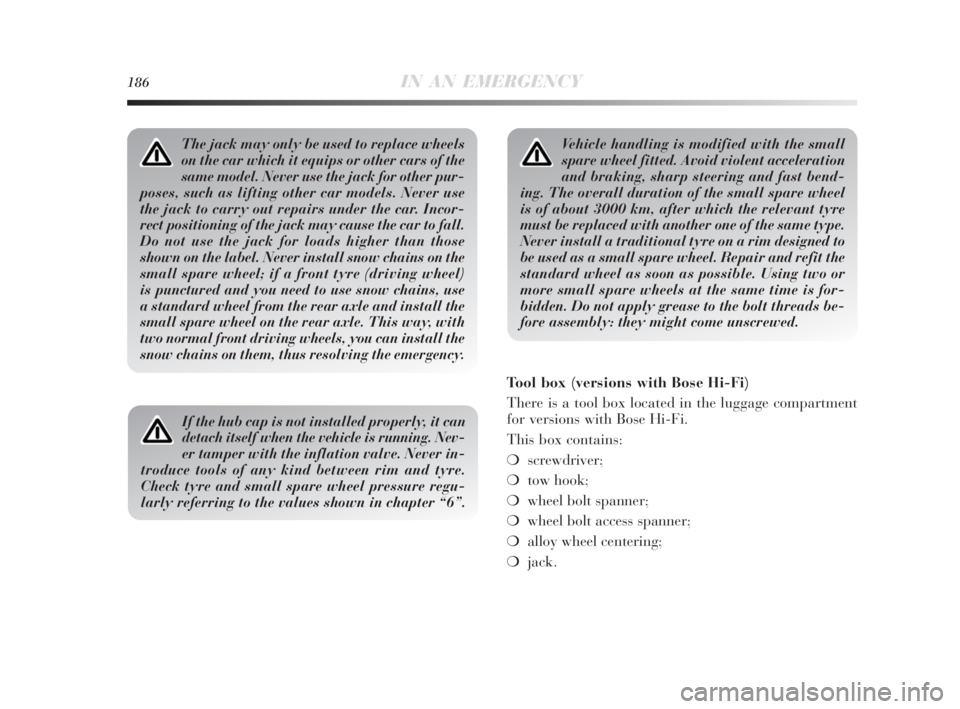
186IN AN EMERGENCY
Vehicle handling is modified with the small
spare wheel fitted. Avoid violent acceleration
and braking, sharp steering and fast bend-
ing. The overall duration of the small spare wheel
is of about 3000 km, after which the relevant tyre
must be replaced with another one of the same type.
Never install a traditional tyre on a rim designed to
be used as a small spare wheel. Repair and refit the
standard wheel as soon as possible. Using two or
more small spare wheels at the same time is for-
bidden. Do not apply grease to the bolt threads be-
fore assembly: they might come unscrewed.The jack may only be used to replace wheels
on the car which it equips or other cars of the
same model. Never use the jack for other pur-
poses, such as lifting other car models. Never use
the jack to carry out repairs under the car. Incor-
rect positioning of the jack may cause the car to fall.
Do not use the jack for loads higher than those
shown on the label. Never install snow chains on the
small spare wheel; if a front tyre (driving wheel)
is punctured and you need to use snow chains, use
a standard wheel from the rear axle and install the
small spare wheel on the rear axle. This way, with
two normal front driving wheels, you can install the
snow chains on them, thus resolving the emergency.
If the hub cap is not installed properly, it can
detach itself when the vehicle is running. Nev-
er tamper with the inflation valve. Never in-
troduce tools of any kind between rim and tyre.
Check tyre and small spare wheel pressure regu-
larly referring to the values shown in chapter “6”.
Tool box (versions with Bose Hi-Fi)
There is a tool box located in the luggage compartment
for versions with Bose Hi-Fi.
This box contains:
❍screwdriver;
❍tow hook;
❍wheel bolt spanner;
❍wheel bolt access spanner;
❍alloy wheel centering;
❍jack.
175-214 Delta 4ed gb 24-02-2010 14:36 Pagina 186
Page 193 of 276
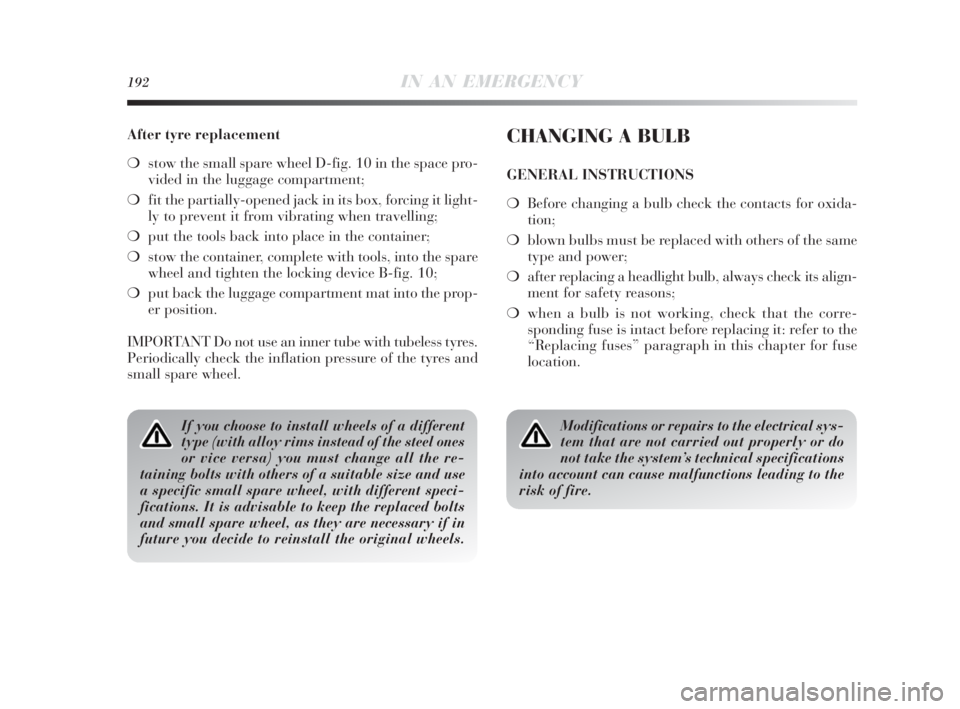
192IN AN EMERGENCY
After tyre replacement
❍stow the small spare wheel D-fig. 10 in the space pro-
vided in the luggage compartment;
❍fit the partially-opened jack in its box, forcing it light-
ly to prevent it from vibrating when travelling;
❍put the tools back into place in the container;
❍stow the container, complete with tools, into the spare
wheel and tighten the locking device B-fig. 10;
❍put back the luggage compartment mat into the prop-
er position.
IMPORTANT Do not use an inner tube with tubeless tyres.
Periodically check the inflation pressure of the tyres and
small spare wheel.CHANGING A BULB
GENERAL INSTRUCTIONS
❍Before changing a bulb check the contacts for oxida-
tion;
❍blown bulbs must be replaced with others of the same
type and power;
❍after replacing a headlight bulb, always check its align-
ment for safety reasons;
❍when a bulb is not working, check that the corre-
sponding fuse is intact before replacing it: refer to the
“Replacing fuses” paragraph in this chapter for fuse
location.
Modifications or repairs to the electrical sys-
tem that are not carried out properly or do
not take the system’s technical specifications
into account can cause malfunctions leading to the
risk of fire. If you choose to install wheels of a different
type (with alloy rims instead of the steel ones
or vice versa) you must change all the re-
taining bolts with others of a suitable size and use
a specific small spare wheel, with different speci-
fications. It is advisable to keep the replaced bolts
and small spare wheel, as they are necessary if in
future you decide to reinstall the original wheels.
175-214 Delta 4ed gb 24-02-2010 14:36 Pagina 192
Page 235 of 276

234CARE AND MAINTENANCE
WHEELS AND TYRES
Check the pressure of each tyre, including the spare wheel,
approximately once every two weeks and before starting
a long journey: this check must be performed with the tyre
rested and cold.
It is normal for the pressure to increase when the car is
used; for the correct tyre inflation pressure, see “Wheels”
in chapter “6”.
Incorrect tyre pressure causes abnormal tyre wear fig. 4:
A normal pressure: evenly worn tread;
B low pressure: tread particularly worn on the edges;
C excessive pressure: tread particularly worn in the mid-
dle.
fig. 4L0E0096m
The tyres must be replaced when the tread is less than 1.6
mm thick. In all cases, follow the laws in force in the coun-
try where you are driving.
IMPORTANT NOTES
❍Avoid braking suddenly, burning starts and violent
knocks against the curb, potholes or other obstacles
where possible. Long distances on rough roads may
damage the tyres;
❍check the tyres regularly for cuts on the sides, swelling
or irregular tread wear. Go to a Lancia Dealership if
required;
❍do not overload your car: this may cause serious dam-
age to wheels and tyres;
❍if a tyre is punctured, stop immediately and change it
to avoid damage to the tyre, wheel rim, suspension and
steering system;
215-242 Delta 3ed gb 11-11-2009 12:14 Pagina 234
Page 236 of 276

CARE AND MAINTENANCE235
5
❍the tyre ages even if rarely used. Cracks in the tread and
on the sidewalls are a sign of ageing. Have the tyres
checked by specialised personnel if they have been fit-
ted for longer than 6 years. Remember to check the spare
wheel very carefully;
❍when replacing the tyres, always fit new tyres, avoid-
ing those of dubious origin;
❍if a tyre is changed, also change the inflation valve;
❍to allow even wear between the front and rear tyres,
it is advisable to change them over every 10-15 thou-
sand kilometres, keeping them on the same side of the
car so as not to reverse the direction of rotation.
Remember that the road holding qualities of
your car also depend on the correct inflation
pressure of the tyres.
If the pressure is too low the tyre will get
overheated, with the risk of serious damage
to the tyre.
Avoid moving the tyres from the right side of
the vehicle to the left side and vice versa.
Do not repaint alloy wheel rims at temper-
atures higher than 150°C. The mechanical
characteristics of the wheels might be dis-
rupted.
215-242 Delta 3ed gb 11-11-2009 12:14 Pagina 235